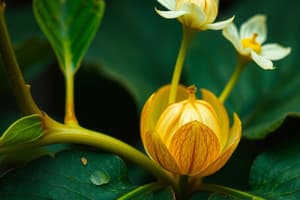Podcast
Questions and Answers
What happens to the runner after the new plant becomes established?
What happens to the runner after the new plant becomes established?
- The runner becomes a new independent plant.
- The runner withers and detaches from the new plant. (correct)
- The runner develops leaves for photosynthesis.
- The runner thrives and continues to grow.
What is the purpose of using rooting powder in cuttings?
What is the purpose of using rooting powder in cuttings?
- To promote rapid root development. (correct)
- To prevent disease in the cuttings.
- To increase the size of the plant.
- To enhance the color of the flowers.
In grafting, what must happen for the two parts to form a single plant?
In grafting, what must happen for the two parts to form a single plant?
- The cambium layers of both must unite. (correct)
- The scion must sprout leaves before grafting.
- The scion must be older than the rootstock.
- The rootstock must be larger than the scion.
Which method involves pegging a cut shoot into the soil?
Which method involves pegging a cut shoot into the soil?
What is a notable feature of micropropagation compared to other methods of artificial propagation?
What is a notable feature of micropropagation compared to other methods of artificial propagation?
What is the function of water in the germination process?
What is the function of water in the germination process?
Which part of the seed emerges first during germination?
Which part of the seed emerges first during germination?
What type of asexual reproduction involves swollen tips of underground stems?
What type of asexual reproduction involves swollen tips of underground stems?
What result occurs once a seedling begins to photosynthesize during germination?
What result occurs once a seedling begins to photosynthesize during germination?
Which type of propagation occurs through structures that survive winter underground?
Which type of propagation occurs through structures that survive winter underground?
What is the primary reason a plant undergoes hypogeal germination?
What is the primary reason a plant undergoes hypogeal germination?
How do strawberry plants primarily reproduce asexually?
How do strawberry plants primarily reproduce asexually?
What is a characteristic of root tubers like sweet potatoes?
What is a characteristic of root tubers like sweet potatoes?
Study Notes
Germination
- The process of seed development into a plant
- Requires water, oxygen, suitable temperature, and food reserves
- Begins with the radicle (root) emerging from the seed and growing downwards
- Followed by the plumule (shoot) growing upwards
- The plant loses weight until leaves emerge and photosynthesis begins
- Plant gains weight once photosynthesis occurs
- Hypogeal germination: seed stays below ground
- Epigeal germination: seed is carried above ground
Asexual Reproduction
- Reproduction without gametes, resulting in genetically identical offspring
- Also known as vegetative propagation
- Commonly used for plant cloning
Natural Propagation
-
Stem Tubers:
- Swollen underground stems, like potatoes
- Contains axillary buds that produce new shoots and roots using stored food
- Parent tuber eventually dies
-
Root Tubers:
- Swollen lateral roots, like sweet potatoes
- Store food and act as perennating organs, allowing the plant to survive through seasons
-
Bulbs:
- Underground swollen bud, like daffodils
- Contains a small stem, terminal bud, and axillary buds enclosed in food-rich leaf bases
- Axillary buds can develop into independent plants using stored food
-
Plantlets:
- Miniature plants formed on leaf edges, like strawberry plants
- Have roots that grow into the ground quickly
- Strawberry plants also produce runners, which are modified stems with plantlets at the end
- Plantlets attached to the parent plant receive nourishment, enhancing survival
- Runners wither once the plantlet becomes independent
Artificial Propagation
-
Cuttings:
- Removing a part of a shoot and planting it in soil or water for root development
- Rooting powder can be used to promote rapid root formation
-
Layering:
- Pegging a cut shoot into soil to develop into a new plant
- Adventitious roots develop after about a year before the new plant is cut off from the parent plant
-
Grafting:
- Joining a shoot (scion) to a rootstock (root)
- Cambium layers unite to form a single plant
-
Micropropagation:
- Growing individual cells (stem, root, or leaf) in tissue culture for plant production
- Useful for houseplants and commercial crops
Studying That Suits You
Use AI to generate personalized quizzes and flashcards to suit your learning preferences.
Description
Explore the fascinating processes of germination and asexual reproduction in plants. Understand how seeds develop into plants and the various methods of natural propagation. This quiz covers key concepts such as hypogeal and epigeal germination, as well as vegetative propagation techniques.




